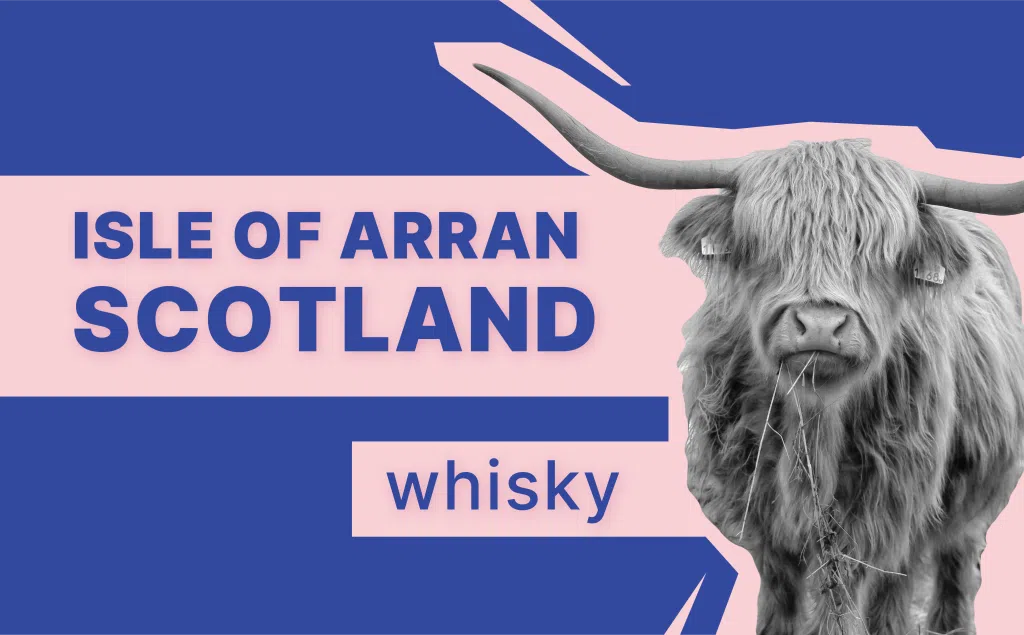The Isle of Arran in Scotland has a new single malt, a delicious heavily peated spirit that’s making waves in the world of whisky. Lagg Distillery was established in 2019 by Arran Whisky, as a sister distillery to Lochranza in the north of the island which launched in 1995. In advance of the release of the first two core spirits from Lagg, manager Graham Omand explains how Lagg began and what we can look forward to from this bold young distillery.
Omand worked as a stillman at Lochranza for eight years before being offered the top job at Lagg. “It was a big step up,” he says, and a huge privilege. “Most people in the industry would commit sins to have the opportunity to work in a distillery from before day one.” Judging by the inaugural releases, he’s the right man for the job.
The Accidental Distillery
You know how it is. You get extra storage space and end up with a new distillery. “Lagg was initially conceived as warehouse space,” Omand explains, “Lochranza was at capacity so we purchased land on Arran. Instead of just warehousing, it was deemed appropriate to have a production site as well. The initial thought was a very small facility to work in tandem with Lochranza. This grew arms and legs during the planning stages, and before we knew it we had a facility that would rival our sister distillery.”
The Demand for Peat
Arran Whisky was confident there was demand for a peated spirit from the Isle of Arran. Peat is essentially decayed vegetation or organic matter that grows naturally in areas such as Peatlands, Bogs or Moors, and it’s been long-used in Lagg’s Single Malts.
“From 2011 onwards, Lochranza had been doing peated malt once a month; what became the Machrie Moor,” Omand says, “But it’s not pleasant or simple to go through the change from peated to non-peated and back. There’s a lot of cleaning involved, and extra distillation to remove the extra phenols. But Machrie Moor was very popular. People were crying out for it.” The decision was made to make Lagg the peated distillery, “and return Lochranza to its initial roots as the non-peated spirit,” Omand says.
A Return to Tradition
While the opening of Lagg is a new chapter for peated whisky on the Isle of Arran, the distillery is reviving a historic island industry. For hundreds of years illicit stills were hidden on farms making what was known as ‘Arran Waters’.
There were official distilleries too, Omand says: “The last legal distillery before Lochranza was just a mile from Lagg on the site of an old flax mill. It closed in the 1840s due to pressure from illegal distilleries and competition from Campbelltown.”
It was originally hoped Arran peat could be used for Lagg, but large swathes of the island are designated sites of specific scientific interest. Malting is also done off-island, “so it would’ve been a case of digging up peat and sending it away,” Omand says. Lagg uses peat from Port Gordon in Speyside, classed as Highland peat.
The use of peat for whisky can pit environmental concerns against historical practices.
“Peated whisky is pretty much a protected historical cultural phenomenon from Scotland, particularly in certain parts of the west coast. We can’t sacrifice what is historically our culture,” Omand says, “But we have a carbon footprint evaluation and we’re applying ourselves to reducing our impact. We’re also reinvesting into peat restoration across Scotland.”
Also interesting: 30 Popular Classic Cocktail List and Recipes.
Creating the Spirit
Barley for Lagg is sourced from north-east Scotland, plus, “a small selection of malted barley from Arran, we only get it a few weeks a year so it’s very special,” Omand says. The grain is malted and then dried in a kiln of burning peat which adds the phenols that create the smoky flavour.
The barley is milled at Lagg before mashing and fermentation. “We have two different fermentation tanks at Lagg: We do a short fermentation of 52 hours and a long fermentation of a hundred hours. We do eight mashes a week, four long, four short. And we mix them to keep consistency because you get different flavours from fermentations,” Omand explains.
The wash produced is twice distilled before maturation. “The heart of the run starts at 73% ABV and at 20 degrees and we’ll end at 63% ABV,” Omand says, “then we send it to the warehouse and cask it twice a week. Right now we’re filling about 110 casks a week at Lagg. So it’s just a constant process from Sunday night into Friday.”
A distillation process designed around the stillmen getting the weekend off is surely one all whisky fans can appreciate.
More about: Types of Alcohol and Liquor.
The First Drams
Lagg’s inaugural release in Autumn 2022 garnered rave reviews. This year the releases will be Kilmory and Corriecravie, both named after nearby villages.
Omand explains the creative process: “For the inaugural batch one. It was kind of a naked whisky. A three-year-old, almost 50% ABV, straight out the door. Love it or like it. It’s young. But this is the base, this is what everything will be compared to. Where we’re going we don’t know, but this is the starting point. Batch two and three were experiments. We used small Rioja and sherry firkin casks—50-litre casks. They imparted a lot of flavour, but that’s not something you would do often because there’s a high loss with these casks.”
“For our next core release we’ve gone back to batch one,” Omand says, “We’re going to have a regular bourbon release, that will be the Kilmory. Just your great bourbon finish, all the flavours, all the notes of the caramel and coffee you’d expect from a bourbon, the sweetness. The Corriecravie will be our house finish. It’ll be two and a half to three years to start with the bourbon cask and then six months finish in the Oloroso sherry hogshead casks.”
More about: 30 Best Whiskey Cocktails & Drinks – 40 Bourbon Cocktails to Master – 12 Best Japanese Whiskey Cocktails
A Community Distillery
Lagg distillery hugs the contours of the island, the turf roof helping it blend into the landscape.
“It was designed in such a way because we spoke to the local community before the design, you don’t actually see the distillery until you are about a mile off it. It’s just fantastic. It’s exactly what everyone wanted,” Omand says.
The distillery has brought jobs to this rural community too: “There aren’t many opportunities locally so we hired local people to work as stillmen, to work in the warehousing and offices, and as tour guides. We’ve definitely provided a lot to the local area for job opportunities. It gives young people the chance to stay.”
How to Enjoy Lagg
Lagg whisky is delicious neat, or as Omand suggests, with a tiny amount of water: “If you want to experiment, just add three drops of water. It changes the hydrophobic and hydrophilic compounds in the whisky, it just brings more to the surface. It’s a completely different whisky. Three drops is, I think, the most efficient way to draw out the flavour with the water without drowning it.”
To visit the distillery get in touch with Lagg.











